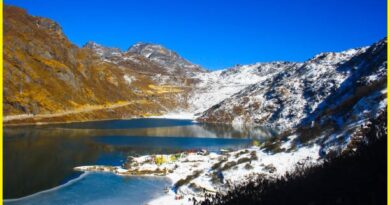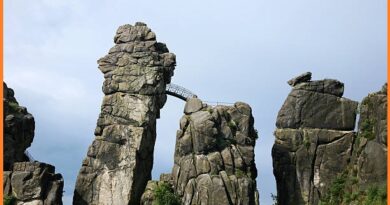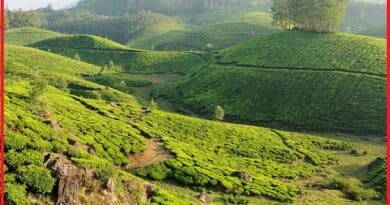Mount Kailash Tibet-The axis of the world and A famous religious center
Mount Kailash Tibet
Mount Kailash is a peak in the Kailas Range in Tibet. The Mount lies near the source of some of the longest Asian rivers- The Brahmaputra, the Sutlej, and the Karnali. Mount Kailash is considered a sacred place in four religions- Bon, Buddhism, Hinduism, and Jainism. Every year thousands of pilgrims make a pilgrimage to the mountain, where they circumambulate Mount Kailash on foot, a distance of 52 km. For Hindus, Kailash is the abode of Shiva and his consort Parvati. Both Buddhists and Hindus view Kailash as the mythical Mount Meru, the central axis of the universe. Such is the sanctity of the 6474m peak that to this day it remains unclimbed.

Geography And Geology
Mount Kailash Tibet is a mountain in the Ngari Prefecture, Tibet Autonomous Region of China. It is situated at an altitude of 6,714 m. The Mount lies in the Kailash Range of the Transhimalaya, in the western part of the Tibetan Plateau. Mount Kailash is less than 100 km towards the north from the western trijunction of the borders of China, India, and Nepal. Mount Kailash is located close to Lake Manasarovar and Lake Rakshastal. The sources of four major Asian rivers lie close to this mountain and the two lakes. These rivers are the Indus, the Sutlej, the Brahmaputra, and the Karnali (A tributary of the Ganges). The area around Mount Kailash Tibet and the Indus headwaters area is characterized by wide-scale faulting of metamorphosed late Cretaceous to mid-Cenozoic sedimentary rocks. This rock has been intruded on by Cenozoic granitic rocks. Mount Kailash Tibet appears to be a metasedimentary roof pendant supported by a massive granite base. The Cenozoic rocks represent offshore marine limestones deposited before the subduction of the Tethys oceanic. These sediments were deposited before the collision between the Indian and Asian continents.

Trekking Mount Kailash Tibet
Kailash gets much of its power from its striking physical location, a lone peak detached from the main Himalayan range in Tibet’s Kangdise mountains. The curiously four-sided mountain rises sheer from the surrounding plain, with its four faces facing the cardinal directions. For Tibetans this is where the Tantric magician Milarepa vanquished his Bon (A Tibetan folk religion) rival Naro Bonchung in an epic battle of sorcery, confirming the dominancy of Buddhism over the existing Bon religion. For Hindus and Buddhists, Kailash is a religious place. Why is mount Kailash unclimbable- Due to religious sentiments Chinese government has banned climbing Mount Kailash’s peak.
Also, read- Ningaloo Reef Marine Animals-A Garden of Coral Reef and UNESCO Site
Walking the Pilgrimage Circuit
The 3-day clockwise walk around Mt. Kailash Tibet is one of Asia’s classic treks. Days are not long (the first and third days are essentially half days) and it’s possible to hire local yaks or porters to carry your gear. You can either camp en route or overnight in simple pilgrim accommodation at the monasteries of Drira-puk and Zutul-puk. You’ll walk with Tibetan nomads, Indian tourists, and Bon pilgrims, passing three monasteries and dozens of sacred sites with rocks carved with stone mantras en route. The most popular time to walk the mountain is during the Saga Dawa festival which usually begins in May and ends in June when thousands of pilgrims descend on the mountain to celebrate Buddha’s enlightenment. A large prayer pole is raised with great fanfare at Tarboche at Kailash’s southwestern corner, after which everybody starts off on their trek.
What to see in the area around Kailash
Lake Manasarovar is a stunning high-altitude lake situated at the foot of Mt, Kailash. Tibetans and Hindus consider it as sacred. Pilgrims walk around the lake for four days stopping en route at the charming lakeshore monasteries of Seralung, Gossul, Trugo, and Chiu. The views of the immense cobalt waters framed by the snow-capped peaks of Kailash and Gurlha Mandata 7728m are truly astonishing.

Travelers can visit Tholing Monastery and the ruins of Guge, a 10th-century Buddhist kingdom in Kashmiri and Ladakhi styles. Explore the murals, tunnels, and hilltop citadel of the former Guge capital at Tsaparang. Try to visit the beautiful Silk Road-style cave murals of Dungkhar and Piyang en route. Permits to Tibet- All foreign tourists need to arrange a tour through a local Tibetan agency in order to get to Tibet. Visitors need to pick this up in China or Kathmandu before arriving in Tibet.
Mt. Kailash Tibet- Axis of the earth
As the four rivers that originate from mount Kailash signify the demarcation of the earth lines, it also represents the four faces of Mount Kailash. Each face of Mouth Kailash Tibet is facing the axis of the world on point and it is the axis of the earth. Mount Kailash Tibet is the reason that all living beings are alive. It maintains the rhythm of the atmospheric balance. Mount Kailash shiva’s face-Mount Kailash resembles Lord Shiva’s third eye The Lapis Lazuli side of the south face of mount Kailash is majestically crowned with snow and flakes that make a garment for Kailash. People say that devotees have seen imagery on the south face of mount Kailash that resembles Lord Shiva’s third eye.

The FOUR faces of Mount Kailash
North face of mount Kailash – Gold
South face of mount Kailash – Lapis Lazuli
East face of mount Kailash – Crystal
West face of mount Kailash- Ruby
Four faces and Shiva Puranas
Shiva Puranas says that each face of Mount Kailash is formed of jewels. Jewels like Lapis Lazuli, Gold, and Ruby. As we all have various emotions, feelings, and traits and we all are unique in our own right. Similarly, all four faces of Mount Kailash depict ‘A’ particular emotions, feelings, and traits.
How to get to Mount Kailash Tibet
The best way to reach Mount Kailash Tibet is to take a flight or train to Lhasa from China or Kathmandu, Start the four-day drive out to the mountain in far Western Tibet. On the way, you can stop off at the Tibetan town of Shigatse and the towering ancient monastery of Sakya, to the stunning north face of Everest Base Camp. In recent years the roads to western Tibet have been paved and hotels are comfortable and scenically stunning drive. On the way back from western Tibet one can get dropped at the Nepal border at Rasuwagadhi, a day’s drive from Kathmandu. This is the best experience descending through the dramatic Alpine-style Kyirong Valley, dropping from the high Tibetan plateau to the edge of the Indian subcontinent.
Sources- Lonelyplanet.com, Wikipedia.org,




Pingback: Mount Abu India-The Hill station, Guru Shikhar, and Its Attraction - Geotourism